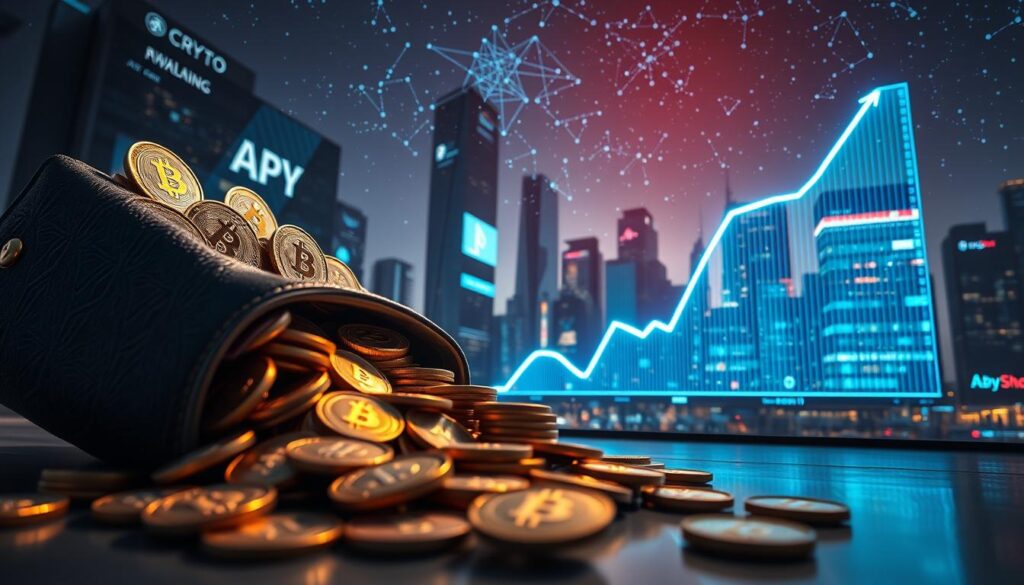Now Reading: Cryptocurrency liquidity pool decentralized exchange: How it Works
- 01
Cryptocurrency liquidity pool decentralized exchange: How it Works
Cryptocurrency liquidity pool decentralized exchange: How it Works

The world of digital asset trading has undergone a massive change. Traditional systems, with their middlemen and slow processes, are being challenged. A new model has emerged, powered by blockchain technology.
This system allows for direct peer-to-peer transactions. It uses smart contracts to automate the entire process. This creates a trustless environment where users have full control.
At the heart of this innovation are automated market makers. These are algorithms that set asset prices automatically. They replace the old order book model used by conventional platforms.
These automated systems rely on a shared reservoir of funds. This is a crowdsourced collection of tokens locked in a smart. It provides the necessary resources for smooth and continuous trading activity across various platforms in the DeFi space.
This guide will explore the mechanics of this groundbreaking approach. You will learn how it solves major problems like price discovery and access. Understanding this technology is essential for anyone involved in modern digital finance.
Key Takeaways
- Digital asset trading has shifted from centralized models to peer-to-peer systems using smart contracts.
- Automated algorithms now set prices, replacing traditional order books.
- Shared reservoirs of funds are crucial for enabling smooth and continuous trading.
- This new model solves challenges like inefficient price discovery and limited market access.
- Grasping these fundamentals is key to participating in modern digital finance.
Introduction to Decentralized Trading and Liquidity Pools
Blockchain has given birth to an entirely new financial ecosystem that operates without traditional gatekeepers. This system, known as Decentralized Finance or DeFi, represents a fundamental shift. It rebuilds familiar services like lending and trading on a transparent, open foundation.
Overview of Decentralized Finance (DeFi)
DeFi emerged as a direct response to the limitations of centralized systems. It offers permissionless access to a wide range of financial tools. Anyone with an internet connection can participate in lending, borrowing, and other activities.
This global network is powered by smart contracts. These automated agreements execute terms without intermediaries. The entire DeFi ecosystem relies on this trustless automation to function smoothly and securely.
The Rise of Liquidity Pools in Modern Crypto Trading
Early decentralized exchanges faced a major hurdle: a lack of market depth. They struggled to match buyers and sellers efficiently. This created a poor user experience and limited growth.
The innovation of shared asset reserves solved this critical problem. Instead of order books, these reserves use algorithms to set prices automatically. This breakthrough enabled continuous trading and billions in volume, making DeFi competitive.
The table below highlights key differences between the old and new models of finance.
| Aspect | Traditional Finance | DeFi Ecosystem |
|---|---|---|
| Control | Centralized Institutions | Individual Users |
| Access | Permissioned & Restricted | Permissionless & Global |
| Transparency | Opaque Processes | Open-Source & Auditable |
| Market Making | Professional Intermediaries | Automated Algorithms & Community |
Breaking Down the Cryptocurrency Liquidity Pool Decentralized Exchange
The architecture supporting peer-to-peer trading relies on a clever financial innovation. This system uses shared reserves of digital assets to enable smooth transactions.

Definition and Key Components
A shared asset reserve is a collection of tokens locked in a smart contract. These reserves form the backbone of modern trading platforms. They eliminate the need for traditional middlemen.
The system has three main parts. First, the smart contract holds the deposited assets securely. Second, token pairs create specific trading markets. Third, mathematical algorithms determine prices automatically.
How It Differs from Traditional Order Books
Traditional platforms use an order book system. This method requires matching specific buy and sell orders. If no counterparty exists at your price, the trade cannot happen.
The new approach solves this problem beautifully. Instead of waiting for matches, traders swap assets directly against the shared reserve. This creates continuous availability for trading any time.
Early platforms struggled with limited participation. The shared reserve model enabled growth by guaranteeing transaction execution. This breakthrough transformed digital asset markets completely.
The Role of Liquidity Pools Within the DeFi Ecosystem
At the core of permissionless financial systems lies a revolutionary approach to market making through collective participation. These shared reserves have become essential infrastructure for modern trading platforms.

Importance for Speed and Efficiency in Trading
Shared asset reserves provide immediate availability for transactions. Traders can execute swaps instantly without waiting for counterparties.
This constant availability eliminates traditional bottlenecks. It ensures smooth operations across various DeFi applications.
How Liquidity Pools Foster Decentralization
These community-driven mechanisms remove centralized intermediaries. Anyone can participate as a market maker without approval.
The system distributes governance power to participants. This creates truly democratic financial networks controlled by users.
| Feature | Centralized Systems | DeFi Approach |
|---|---|---|
| Market Access | Limited to approved participants | Open to anyone globally |
| Transaction Speed | Dependent on order matching | Instant against shared reserves |
| Control Structure | Hierarchical with intermediaries | Distributed among users |
| Availability | Market hours restrictions | 24/7 continuous operation |
Mechanics of How Liquidity Pools Work
Mathematical algorithms and automated protocols form the foundation of contemporary asset trading platforms. These systems operate through sophisticated mechanisms that ensure smooth market operations.

Automated Market Makers and Smart Contracts
Liquidity providers deposit pairs of digital assets into shared reserves. They typically contribute equal values of two different tokens. Advanced models allow for different ratios based on specific smart contracts.
Automated market makers use mathematical formulas to determine prices. The most famous formula is Uniswap’s constant product formula (x * y = k). This maintains balance by keeping the product of token quantities constant.
LP Tokens and Fee Distribution
When users supply assets, they receive LP tokens representing their share. These tokens serve as claim tickets for original deposits and accumulated fees. They can be used throughout the ecosystem as collateral or in yield strategies.
Each trade generates a small fee, typically 0.1% to 0.3%. This fee is proportionally distributed to all LP token holders. The distribution reflects each provider’s share of the total reserve.
| Feature | Traditional Market Making | Automated Systems |
|---|---|---|
| Price Determination | Manual order matching | Mathematical algorithms |
| Participation | Limited to professionals | Open to all users |
| Fee Distribution | Centralized allocation | Proportional to contribution |
| Operation | Market hours only | 24/7 continuous |
Benefits and Risks of Using Liquidity Pools
Modern financial protocols present users with a dual-faced opportunity that combines earning potential with various hazards. Understanding both sides is crucial for making informed decisions in digital asset markets.

These systems offer attractive advantages but also carry significant concerns. A balanced approach helps participants navigate this landscape effectively.
Advantages: Continuous Liquidity and Yield Opportunities
Shared reserves provide constant market access without waiting for counterparties. This eliminates slippage issues that plagued earlier trading systems.
Providers earn passive income from transaction fees. Some arrangements generate returns exceeding traditional investments.
Potential Risks: Impermanent Loss and Security Vulnerabilities
The main concern for contributors is impermanent loss. This occurs when paired assets change in price ratio differently.
Smart contract flaws and fraudulent projects represent additional hazards. Real incidents have resulted in substantial financial losses for participants.
| Benefit | Risk | Impact/Example |
|---|---|---|
| 24/7 market access | Impermanent loss | Value reduction when assets diverge |
| Fee-based earnings | Smart contract bugs | Harvest Finance hack ($33.8M loss) |
| Democratic participation | Rug pull scams | AnubisDAO incident ($60M loss) |
| Reduced slippage | Price volatility effects | Large orders affecting execution price |
Exploring Automated Market Maker (AMM) Technologies
Algorithmic price-setting mechanisms have transformed how assets are valued and exchanged. These automated systems use mathematical formulas embedded in smart contracts to determine values.
This approach eliminates human intermediaries from the pricing process. It creates more efficient and transparent markets for participants.
How AMMs Set Prices Using Mathematical Formulas
The most famous formula is Uniswap’s constant product model (x * y = k). This equation maintains that the product of two token quantities remains constant.
When traders buy one asset, its quantity decreases while its price increases. The opposite asset becomes more abundant and cheaper automatically.
This creates a self-balancing system that responds to market demand. The algorithm ensures continuous availability for all trading activities.
Examples of AMM Models in Popular Platforms
Different platforms use specialized formulas for specific market needs. Curve Finance’s stableswap model optimizes for stablecoin pairs.
Balancer allows multiple tokens with custom weight ratios. This enables more complex portfolio management through shared reserves.
Each design serves distinct purposes in the digital asset ecosystem. They demonstrate the evolution of algorithmic market-making technology.
| Platform | AMM Model | Primary Use Case | Key Feature |
|---|---|---|---|
| Uniswap | Constant Product (x*y=k) | General token pairs | Simple, universal application |
| Curve Finance | Stableswap algorithm | Stablecoin trading | Low slippage for similar assets |
| Balancer | Weighted pool formula | Multi-asset management | Custom token ratios |
These technologies represent significant advances in financial automation. They provide the foundation for modern digital market operations.
Yield Farming and Incentives for Liquidity Providers
Beyond basic trading fees, advanced protocols offer sophisticated incentive structures to attract capital. These systems create additional earning opportunities for participants who supply market resources.
Understanding Yield Farming and Liquidity Mining
Yield farming involves staking digital assets to generate tokenized rewards. Participants lock up their holdings in various protocols to earn additional tokens.
Liquidity mining focuses on specific incentivized reserves. Providers target these opportunities to maximize their earnings beyond standard fees.
These strategies create multiple income streams. They help bootstrap new markets and trading pairs effectively.
Incentives and Reward Mechanisms in DeFi
Protocols use creative tokenomics to attract contributors. Common approaches include bonus multipliers and tiered reward structures.
Governance token distribution remains a popular method. Platforms allocate native tokens to participants over specific time periods.
These incentive designs must balance short-term attraction with long-term sustainability. Excessive token emission can lead to dilution concerns.
| Feature | Traditional Incentives | Modern Yield Farming |
|---|---|---|
| Reward Source | Fixed fee percentages | Multiple token streams |
| Participation | Limited allocation | Open to all providers |
| Time Commitment | Short-term focus | Long-term incentives |
| Risk Profile | Lower variability | Higher potential returns |
Understanding these structures helps participants evaluate opportunities effectively. Strategic capital movement between platforms can optimize earnings while managing risks.
Top Examples of Crypto Liquidity Pools in 2025
Leading platforms demonstrate how algorithmic trading mechanisms have evolved to serve different market needs. These systems showcase innovative approaches to digital asset markets.
Insights from Uniswap, Balancer, and Bancor
Uniswap remains the pioneering automated market maker. It uses a simple 1:1 ratio for token pairs with a 0.3% fee structure. The platform offers massive depth for Ethereum-based assets.
Balancer provides multi-asset pools with customizable weightings. This platform functions as both a market maker and portfolio manager. Its modular design supports various pooling strategies.
Bancor introduced single-sided provision and impermanent loss protection. This unique approach differentiates it from competitors. The system maintains constant ratios across connected tokens.
| Platform | Specialization | Key Feature | Fee Structure |
|---|---|---|---|
| Uniswap | General token pairs | Simple 1:1 ratio | 0.3% standard |
| Balancer | Multi-asset management | Custom weightings | Variable rates |
| Bancor | Single-sided provision | Loss protection | Algorithm-based |
| Curve Finance | Stablecoin trading | Low slippage | Optimized rates |
Additional platforms like SushiSwap and PancakeSwap show ecosystem diversity. This information comes from 101blockchains.com research on leading protocols.
Security Measures and Smart Contract Best Practices
Protecting your digital assets requires careful attention to security protocols. These systems operate on code, making vigilance essential for all participants.
Understanding potential risks helps users make safer choices. A proactive approach significantly reduces exposure to common threats.
Importance of Using Audited Platforms
Always choose platforms that have passed independent security reviews. These audits check the code for hidden flaws.
Established platforms have a history of safe operation. Even audited systems are not completely risk-free, however.
Tools and Strategies for Mitigating Risks
Several strategies can protect your investments. Diversifying across different pools limits potential losses from a single issue.
Specialized insurance can cover losses from smart contract failures. Monitoring tools provide real-time alerts for unusual activity.
Thorough research is your best defense. Check a project’s team, token distribution, and community feedback before committing funds.
| Security Practice | Primary Benefit | Example Tool/Approach |
|---|---|---|
| Platform Audits | Identifies code vulnerabilities | Independent security firms |
| Multi-signature Wallets | Prevents unauthorized access | Gnosis Safe |
| Portfolio Diversification | Limits exposure to single point of failure | Spreading assets across protocols |
| Real-time Monitoring | Early warning for suspicious activity | Tenderly, OpenZeppelin Defender |
Future Trends and Technological Innovations in Liquidity Pools
Interoperability represents the next frontier for automated trading systems. New protocols are developing solutions that connect different blockchain networks. This addresses the fragmentation that currently limits capital efficiency.
Emerging Protocols and Cross-Chain Solutions
Cross-chain technology allows assets to move seamlessly between networks. Users can trade tokens from different blockchains without manual bridging. This creates more efficient markets with better pricing.
DEX aggregators connect multiple pools into unified interfaces. They automatically find the best prices across different platforms. This innovation significantly improves the trading experience for all participants.
Predictions for the Next Bull Run and Market Evolution
Future market growth will demand more sophisticated infrastructure. Layer-2 scaling and concentrated liquidity will handle increased volume. These improvements will reduce costs and improve execution.
New protocols are experimenting with hybrid systems and AI optimization. Understanding these analyzing crypto liquidity pools trends helps participants prepare for coming opportunities. The ecosystem continues evolving toward greater efficiency and accessibility.
Conclusion
A new era of financial participation has emerged, empowering users through algorithmic market-making solutions. These systems have transformed how digital assets are traded globally.
Shared reserves solved critical problems that limited early platforms. They provide continuous market access without traditional order matching. This breakthrough democratized market participation for all users.
Providers can earn passive income while improving trading efficiency. However, understanding risks like impermanent loss remains essential for safe participation.
The growth of these automated systems supports broader adoption of digital finance. Ongoing innovations in cross-chain technology will further enhance accessibility.
Continuous learning and security vigilance are crucial in this evolving landscape. Responsible exploration of these opportunities can contribute to the expanding financial ecosystem.
FAQ
What is a liquidity pool in a decentralized exchange?
A liquidity pool is a smart contract that holds funds. Instead of an order book, it uses an automated market maker (AMM) to set asset prices. This allows users to trade tokens directly from the shared reserves provided by liquidity providers.
How do automated market makers determine the price of tokens?
Automated market makers use mathematical formulas, like the constant product formula, to set prices algorithmically. The price changes based on the ratio of assets within the pool, ensuring continuous trading without needing buyers and sellers to match orders.
What is impermanent loss?
Impermanent loss is a potential risk for providers. It occurs when the price of your deposited assets changes compared to when you entered the pool. If the price divergence is significant, you may earn less than if you had simply held the assets.
What are LP tokens?
LP tokens are proof of your contribution to a pool. When you deposit assets, you receive these tokens representing your share. They are used to claim your portion of the trading fees when you withdraw your funds from the smart contract.
How can I start providing liquidity?
To become a provider, you first need a compatible Web3 wallet like MetaMask. Then, connect to a platform like Uniswap or Balancer, select a pool, and deposit an equal value of two tokens. You will instantly begin earning a portion of the fees from trades.
Are these platforms safe to use?
Security varies by platform. It is crucial to use well-established, audited protocols. Even then, risks like smart contract bugs exist. Always research a project’s security audits and community reputation before depositing any funds.
What is yield farming?
Yield farming, or liquidity mining, is a way to earn extra rewards. Beyond standard trading fees, protocols often offer additional token incentives to attract providers to specific pools, boosting the overall returns on your deposited assets.














